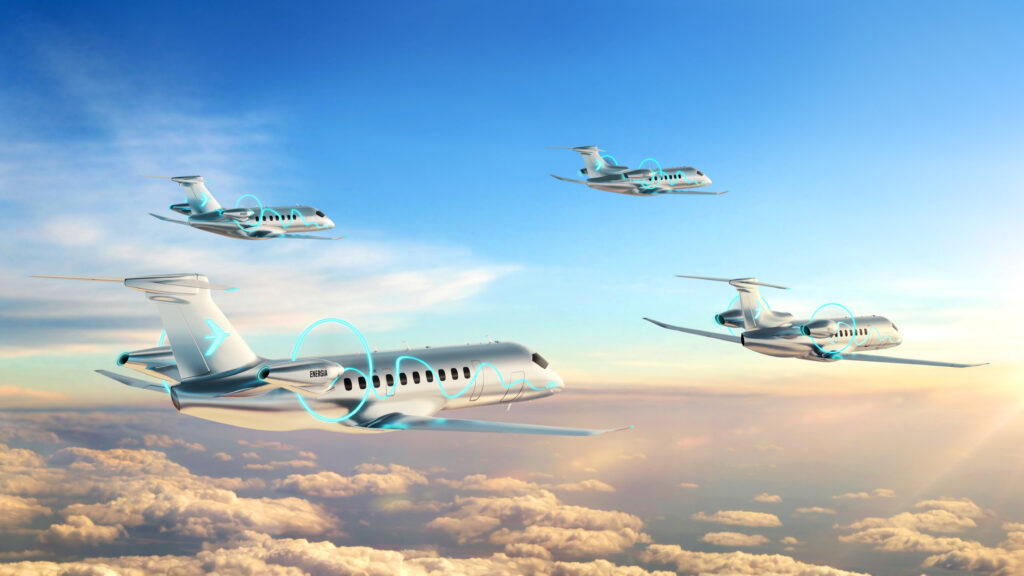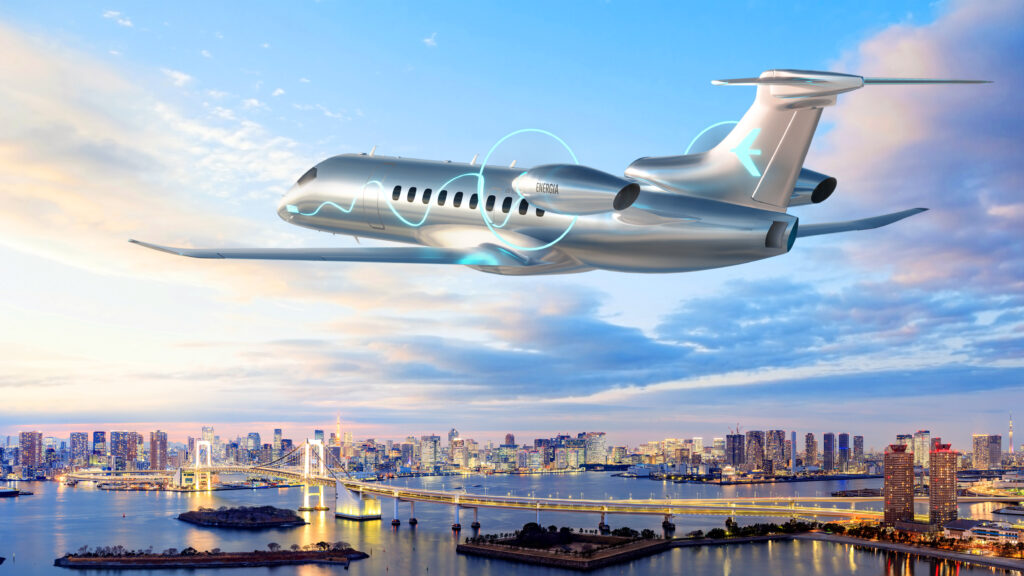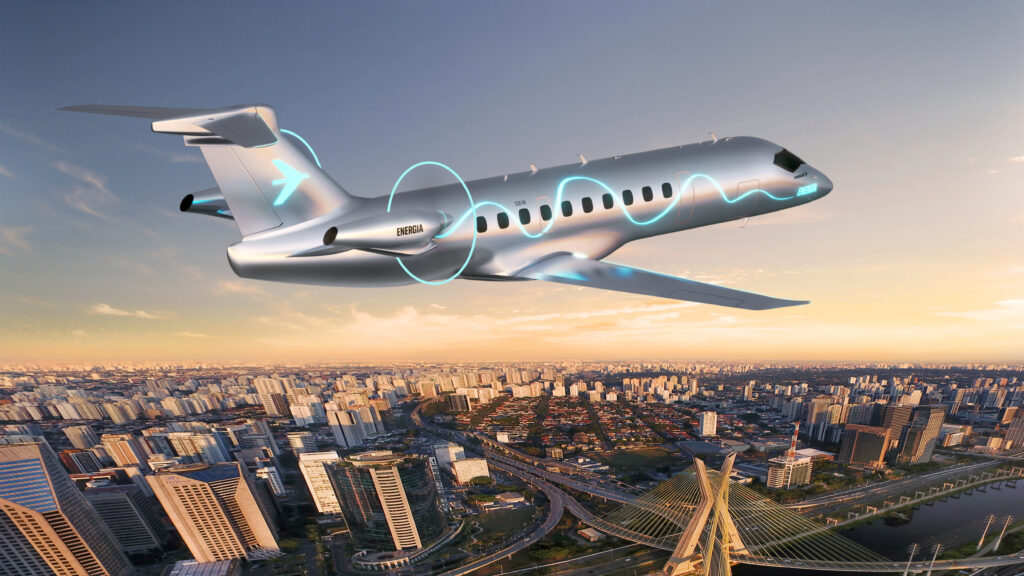Estimated reading time 7 minutes, 34 seconds.
During a live YouTube broadcast on Dec. 5, Embraer revealed updated aircraft concepts from its new Energia family, as part of the company’s progress report on the initiative.
Embraer first announced the Energia family of concept aircraft in November 2021 as a potential solution to help the industry achieve its goal of net-zero carbon emissions by 2050. The aircraft family includes four concepts, varying in size, that incorporate different propulsion technologies including electric, hydrogen fuel cell, dual fuel gas turbine, and hybrid-electric.

The OEM has now shared its progress on the hybrid and hydrogen fuel cell concepts, known as Energia Hybrid and Energia H2 Fuel Cell. The latter was originally unveiled as a 19-seat concept in 2021, but Embraer is now exploring a 30-seat variant (E30-H2FC) — in addition to the 19-seat concept (E19-H2FC).
The 19-seat version “is a high-performance, faster, shorter fuel platform, while the 30-seater offers better economics per seat,” the OEM said.
Both variants of the Energia H2 Fuel Cell are sized to have a range of “at least” 200 nautical miles, Embraer said, adding that regulatory energy reserves are included in this number, “which also considers degradations while aging in service.”
The Energia H2 Fuel Cell features rear-mounted electric engines, and operates using hydrogen-powered electric propulsion — resulting in zero CO2 emissions. The aircraft’s design would also reduce external noise by 70 percent.
As for the Energia Hybrid, it was originally revealed as a nine-seat concept in 2021. Now, Embraer is exploring both a 19-seat (E19-HE) and 30-seat (E30-HE) variant. The aircraft would be capable of operating on 100 percent sustainable aviation fuel (SAF), and would produce 90 percent less CO2 as a result.
Both the 19-seat and 30-seat variant are expected to have a range of 500 nautical miles. Moreover, the rear-mounted engines with optimized propeller design would reduce external noise by 60 percent.
Compared to the Energia H2 Fuel Cell, the Energia Hybrid is smaller and lighter. The aircraft concept features a smaller wing, “which is repositioned due to center of gravity reasons,” the company said.

Moreover, there is no need for an air inlet at the base of the vertical tail. “This is because the Energia Hybrid does not require large heat exchangers. It employs a parallel hybrid-electric architecture that maximizes the synergies between thermal and electric agents.”
The design features small electric engines, to be used when shorter power boosts are required — such as when the aircraft is taxiing, taking off, or climbing. “By doing so, we avoided utilization of large batteries, which would add significant weight and costs to the aircraft,” the OEM said.
The architectures and technologies of the Energia concept aircraft are still in the evaluation phase and are being assessed for technical and commercial viability. Through its new Energia Advisory Group, Embraer is collaborating with partner airlines and taking advantage of their inputs. The group consists of 25 participants from over 20 airlines.
The company is also collaborating with a variety of manufacturers to bring its concepts to fruition. Embraer is working with the traditional powerplant manufacturers that it has worked with in the past, but is working with start-ups as well. “We’re also working with manufacturers of systems that didn’t exist in the traditional systems, like the thermal management system” on the Energia H2 Fuel Cell.
Currently, Embraer is aiming for the Energia Hybrid technology to be ready by the early 2030s, while the outlook for the Energia H2 Fuel Cell is 2035.
“I believe we have set bold but realistic goals for these concepts to come to market,” said Arjan Meijer, president and CEO of Embraer Commercial Aviation. “Since we announced our Energia concepts last year, we have been busy evaluating different architectures and propulsion systems. These efforts have resulted in the updates of our concepts that we are sharing with you today. A number of airlines are part of our Energia Advisory Group; the experience and knowledge they bring to the study will be key to accelerate to the next phases.”

According to Meijer, hydrogen is likely to be one of the biggest challenges with bringing this type of technology to market. “To get enough green hydrogen produced, to get hydrogen access to airports, and to get it on the aircraft, that’s building a whole new infrastructure,” he said. “I think the technology for SAF and hybrid are lower hanging fruit, and hydrogen is more complex technology. . . . It will take a bit longer to get there.”
Embraer’s engineering team is nearing the completion of the first phase of concept exploration and evaluation, and will soon move on to the second phase.
“As new propulsion technologies will be first applied on smaller aircraft, Embraer is in a unique position,” said Luis Carlos Affonso, senior VP of engineering, technology and corporate strategy at Embraer. “The 19 and 30 seaters are sensible starting points for focused studies since they are likely to present earlier technical and economical readiness.”








